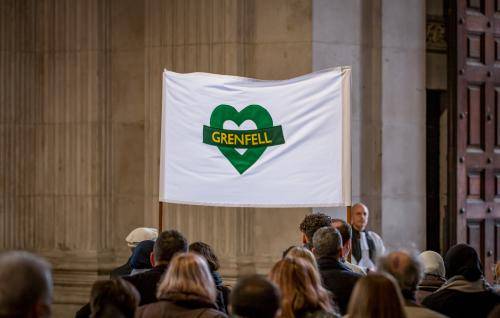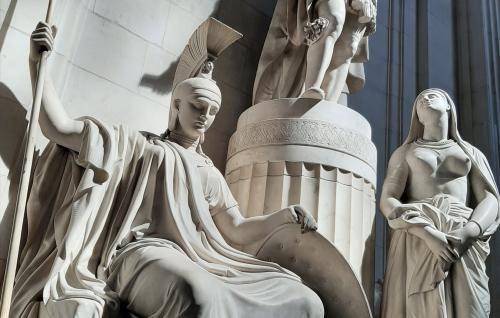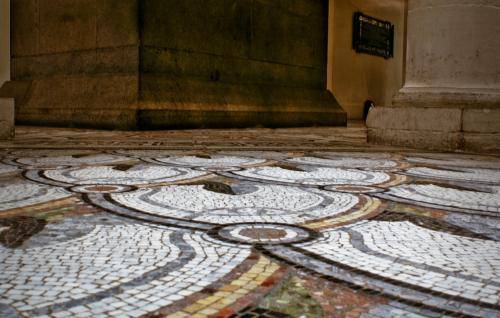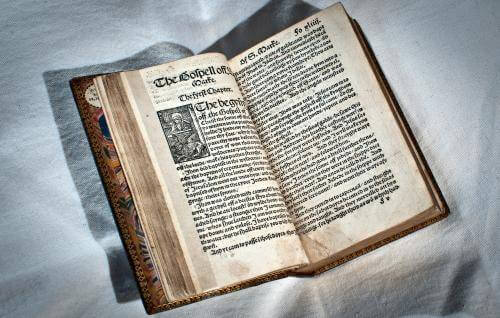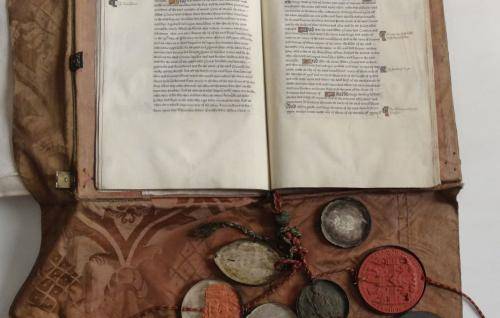Royal Jubilees
Her Majesty Queen Elizabeth II entering St Paul's Cathedral for the Thanksgiving Service to celebrate her Diamond Jubilee, 2012.
Royal Jubilees
Royal Jubilees are joyous occasions, which celebrate major periods in a monarch's reign. The first Diamond Jubilee, for Queen Victoria, took place over a century ago and celebrations were held over three days in June 1897.
Queen Victoria bypassed what would have been her Silver Jubilee in 1862, as she had retreated from public view after the untimely death of Prince Albert the year before. A quarter of a century later in 1887, she celebrated her Golden Jubilee, and a decade after, marked her Diamond Jubilee. Victoria became the first British Monarch to reign for sixty years, surpassing King George III’s previous record of 59 years.
Since Victoria’s Diamond Jubilee, we have celebrated Kind George V’s Silver Jubilee in 1935 and our current Queen Elizabeth II’s Silver (1977), Golden (2002) and Diamond (2012) Jubilees. Queen Elizabeth is now both our oldest and longest-serving Monarch.
Queen Victoria’s Diamond Jubilee 1897
On the bank holiday of 22 June 1897, Queen Victoria’s National Service of Thanksgiving was held outside St Paul’s at the foot of the west steps.
Because Victoria was so frail, she remained in her carriage throughout the ceremony where the clergy joined her, surrounded by dignitaries and troops from around the Empire. At only twenty minutes long, the ceremony consisted of a performance of a Te Deum by a huge orchestra and choir, prayers, benediction and the ‘Old Hundredth’.
The procession carrying the Queen and her guests to St Paul’s was seventeen carriages long and included members of her own Royal Family as well as others from around the world. Queen Victoria travelled in a carriage pulled by eight cream horses and was accompanied by her third daughter, Helena, Princess Christian of Schleswig-Holstein and the Princess of Wales (later Queen Alexandra).
After the ceremony, the Queen toured a large area of London on her way back to Buckingham Palace, stopping at Mansion House to be welcomed into the City of London by the Lord Mayor. The day was extremely popular with the people of Britain and 25,000 seats had to be erected along the six-mile processional route. There was also special seating at St Paul’s, which had audience seating constructed at the top of the west steps creating a marvellous view of the service. The dome was also in the spotlight – lit up by searchlights from the roofs of the surrounding warehouses.
The Jubilee celebrations ended up lasting a fortnight, despite Queen Victoria originally requesting they last only one day. These celebrations included military reviews, a garden party at Buckingham Palace, concerts, a state banquet and receptions as well as numerous public celebrations. The Poet Laureate at the time, Mr Alfred Austin, also presented Queen Victoria with a specially written poem entitled ‘Victoria’.
King George V’s Silver Jubilee – 1935
For Georges V’s Silver Jubilee celebrations in May 1935, there was a busy programme of events, beginning with a special service of Thanksgiving at St Paul’s on 6 May.
The day was declared a public holiday and parties were held across London in the glorious sunshine, as well as up and down the country with fêtes, pageants and sports events. Later that day, the King and Royal Family appeared on the balcony of Buckingham Palace to floods of cheers from the crowd below. Due to popular demand, the King even waved from the same balcony for a few consecutive days later in the week.
George V continued to mark the Jubilee throughout May, taking carriage rides through London – one for Queen Mary’s birthday, on which they were accompanied by their two granddaughters, Margaret and the future Queen Elizabeth.
During the celebrations the King received an extensive number of telegrams from across the globe with good wishes, both from heads of state and ordinary people. The public’s reaction to George V’s appearances over the celebratory period only confirmed the popularity of a Jubilee celebration as well as the esteem in which the King was held.
Queen Elizabeth II’s Silver Jubilee – 1977
Queen Elizabeth II celebrated her first Jubilee and 25 years on the throne on the first weekend of June 1977.
It was on 7 June that the Service of Thanksgiving at St Paul’s took place, as well as the Jubilee procession in front of almost a million spectators and five million television viewers. After the service, the Queen broke with usual custom and took a walk through London to see the people that had turned out to see her. The day was made a bank holiday and across the country communities joined together for street parties, processions and fêtes. Following tradition, the Queen also lit a bonfire that would light a chain of beacons across Britain.
On 9 June, the Queen journeyed up the Thames aboard the Royal Yacht Brittania on a river progress, and later, opened the Silver Jubilee walkway which connects many of London’s landmarks.
In this Jubilee year, the Queen toured much of Britain – and crucially, for the first time ventured abroad with the Duke of Edinburgh to visit every country in the Commonwealth. This trip was split into two tours. For the first leg in February, the Queen visited New Zealand, Australia, Tonga, Western Samoa, Fiji and Papua New Guinea, then in October it was on to Canada and the Caribbean.
Queen Elizabeth II’s Golden Jubilee – 2002
Queen Elizabeth’s Golden Jubilee, to mark her 50 years on the throne, was celebrated in early June 2002, despite the sad deaths of both her sister Princess Margaret and the Queen Mother earlier in the year.
On 4 June, the Queen attended the service of Thanksgiving at St Paul’s, arriving in the Gold State Coach pulled by eight horses. The day before the service, the Queen had lit the customary and long-established Jubilee Beacon, this time at the Victoria memorial outside Buckingham Palace. The beacon in turn lit 2,002 beacons stretching right across the Commonwealth countries and as far as Antarctica.
Over the Jubilee year, the Queen again went abroad and visited some of the Commonwealth countries, as well as paying a visit to 70 towns and cities across Britain.
Whilst the more traditional events to mark the Queen’s accession were still held, the Jubilee program of 2002 was also adjusted to reflect modern Britain. The Queen paid a visit to all the main faith communities in Britain and held a multi faith reception at Buckingham Palace, attended by hundreds of different faith representatives. The Queen also held six Jubilee garden parties over the course of the summer in London and Edinburgh, with an invite list made up of those born on the Queen’s accession day in 1952. Buckingham Palace also held ‘Party at the Palace’ – their very first rock concert within the grounds.
Queen Elizabeth II’s Diamond Jubilee – 2012
The much anticipated Diamond Jubilee of Queen Elizabeth II was celebrated from 2–5 June 2012, with numerous events throughout the UK and across the Commonwealth.
Following in Queen Victoria’s footsteps, Queen Elizabeth attended a National Service of Thanksgiving at St Paul’s Cathedral on the final day of her Diamond Jubilee celebrations.
The service opened with a Bidding given by The Very Reverend Dr David Ison, the new Dean of St Paul’s. Later, the Right Honorable David Cameron MP provided a reading from the New Testament reading by, and The Most Reverend Dr Rowan Williams, Archbishop of Canterbury, preached a Sermon. The Collect – a special prayer written by St Paul’s Chapter, with guidance from the Queen herself – was read by the Bishop of London.
The Litany and Prayer of Thanksgiving also included readings by numerous inspirational young people involved in charities and awards. These included a Young Ambassador of the Year from The Prince's Trust and a Queen’s Scout.
There was also a great variety of music from the combined choirs of the St Paul’s Cathedral and Her Majesty’s Chapel Royal, as well as the specially appointed Diamond Choir. They sang a new piece to the Queen entitled ‘The Call of Wisdom’, by composer Will Todd. The State Trumpeters of the Household Cavalry, The Fanfare Trumpeters of the Central Band of the Royal Air force and The Band of the Welsh Guards also performed.
The service had a congregation of over 2,000, with guests made up of Members of the Royal Family, figures from Government and Law, Realm Prime ministers, Officers of State, Governors General and representatives from a variety of faiths.
Over the long weekend, the Queen – who was 85 – had quite a schedule. She attended the Epsom Derby on Saturday 2, The Thames Diamond Jubilee Pageant on Sunday 3, the BBC Concert at Buckingham Palace on Monday 4, and a RAF fly-past following the Procession and service of Thanksgiving on Tuesday 5.
Up and down the country, celebrations over the four-day weekend took the form of street parties and fairs. Across London, spectators turned out in their thousands to catch a glimpse of the Queen, particularly for the river pageant where there were an estimated 1 million people watching from the banks of the river.





